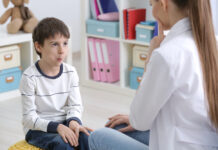In a featured article for Psychiatric Services, psychiatrists from Dartmouth raise the alarm on the increasing numbers of children prescribed dangerous antipsychotic drugs. Despite the fact that data on the safety of long-term use of these drugs in this vulnerable population “do not exist,” the rate of children and adolescents being prescribed antipsychotic drugs have continued to increase over the past fifteen years.
“The crux of the issue is this: Children in the United States have increasingly been prescribed antipsychotic medications despite potentially serious short- and long-term side effects,” the authors write. “Yet other efficacious and safer interventions are available.”
 Though there is a lack of quality research on the use of antipsychotics in children, existing studies reveal that side-effects like rapid weight gain and adverse hormonal effects are more extreme in children. Other serious side effects include fainting, sedation, gastrointestinal issues, metabolic syndrome, hypertension, abnormal breast development and even potentially irreversible movement disorders like Parkinson’s disorder, akathisia (restlessness), and tardive dyskinesia. Due to the dearth in research, the long-term effects in children are unknown, but it has been linked to obesity, diabetes, heart disease, reduced social functioning and “progressive neurotoxicity” in young adults.
Though there is a lack of quality research on the use of antipsychotics in children, existing studies reveal that side-effects like rapid weight gain and adverse hormonal effects are more extreme in children. Other serious side effects include fainting, sedation, gastrointestinal issues, metabolic syndrome, hypertension, abnormal breast development and even potentially irreversible movement disorders like Parkinson’s disorder, akathisia (restlessness), and tardive dyskinesia. Due to the dearth in research, the long-term effects in children are unknown, but it has been linked to obesity, diabetes, heart disease, reduced social functioning and “progressive neurotoxicity” in young adults.
“We should be concerned about overuse of antipsychotics for many reasons. Children are inherently vulnerable because their brains and bodies are still developing and may be permanently altered by powerful medications.”
While the FDA has approved antipsychotic drugs for children who have been diagnosed with schizophrenia, bipolar disorder, and “severe behavior problems associated with autism,” the study authors point out that most randomized control trials for these uses have been “brief, and many have been sponsored by industry.” However, the majority of antipsychotic prescriptions in children are “off-label,” meaning they are prescribed in the absence of a diagnosis for which they are approved. Recent analysis shows that the most common diagnoses for a child prescribed an antipsychotic drug is ADHD and “the most vulnerable children— those in foster care, the juvenile justice system, and institutions— have been the most likely to receive antipsychotics.”
“Their disruptive behaviors are often related to disruptive parenting and stressful environments, which deserve primary attention. Adults may be motivated by the desire to achieve short-term control of behavior rather than to enhance children’s long-term growth and development.”
The authors also point out that psychosocial interventions and different forms of psychotherapy have been shown to be effective alternatives. “On the basis of the available evidence,” they add, “a workgroup of the American Academy of Child and Adolescent Psychiatry has recommended psychosocial rather than pharmacological interventions as the first-line treatment for children with aggressive behaviors.”
The paper presents five recommendations for decreasing the use of antipsychotics. First, preventative care can address socioenvironmental problems. They note that other wealthy countries provide for extended maternal leave and family supports and that children receiving antipsychotics “often come from situations of family disruption, neglect, trauma, abuse, changes in parenting and guardianship, poverty, environmental exposure to toxins, and other stressors.” Second, they stress the need to make mental health professional more aware of safer, evidence-based therapies and interventions and of the dangerous effects of antipsychotics in children. Third, changes in clinical guidelines should be made, and additional steps should be taken to increase compliance to these guidelines. Fourth, they suggest shared decision making. Clinicians, patients, and parents all need better information on antipsychotics and should all be involved in deciding on appropriate treatment methods. Lastly, education programs should be undertaken to reach the agencies and counselors who take care of and support vulnerable children.
“Health professionals, researchers, families, and legal guardians must protect children. Clinicians have an ethical obligation to provide evidence-based treatment—but also to do no harm.”
*
Daviss, W. B., Barnett, E., Neubacher, K., & Drake, R. E. (2016). Use of Antipsychotic Medications for Nonpsychotic Children: Risks and Implications for Mental Health Services. Psychiatric Services. (Abstract)















So where are the new articles questioning long-term use of antipsychotics in adults? Because that evidence base just got exposed as non-existent. Arguably long-term use of antipsychotics in adults should no longer be allowed on any large-scale because there is no evidence of efficacy and too many safety risks.
Report comment
As one whose drug withdrawal induced “super sensitivity manic psychosis” took the form of a weird spiritual story, where Jesus supposedly claimed, “all the doctors are going to hell.” I do now understand why Jesus would have been disgusted with the medical community in 2009. And I agree that, those doctors putting children on antipsychotics, or any doctor forcing or coercing these drugs onto anyone, especially based upon scientifically invalid “mental illnesses,” does indeed deserve to be treated as they treated others. In other words, they do deserve to be defamed and tortured, and the psychiatrists believe this defamation and torture should last for one’s entire lifetime. I didn’t realize there would even need to be a “hell.”
I had thought back then, that I had just run into some bad doctors. I had no idea that seemingly almost the entire medical industry was too stupid to learn from WWII, that making up “mental illnesses” and torturing and killing people based upon these fictions, was unacceptable human behavior. “Those who cannot remember the past are condemned to repeat it.”
STOP TORTURING AND KILLING OUR CHILDREN, DOCTORS!
Report comment
Working with young adults, the treatment is often mortifying even in the popular “sanctuary” model facilities I’ve visited. The children are drugged for their behaviors, not any diagnosed mental health concern (and most of them are situational…”adjustment disorder” tends to be a popular label.) The tough part is that many of the children thrive in these communities because they are away from their families who are not willing to address all the issues listed in the article that contribute to the situation. The families have issues, but push the child into treatment and say HERE! Fix him/her and WE’LL be fine. The kid does well apart from the family because they family is a nightmare, doesn’t see itself as needing any improvements and when the child returns, he/she falls apart again and the treatment loop starts over (more involuntary treatment, more drugs, etc…) If the child isn’t resilient, they age into the adult system with a record as thick as a phone book and have spent more time in hospital than in school.
Report comment
Really pertinent comment that speaks to the heart of how and why at least one segment of the child population gets drugged. Opportunity, denial, and abdication of responsibility on the part of anyone.
Liz Sydney
Report comment
I’ve followed the trend to deliver antipsychotics to young children for a few years now. At some points (even very recently) ‘expert’ researchers and ‘expert’ prescribers became very excited about delivering antipsychotics simultaneously with other psychopharma to just about any random, uncontrollable brat, and published papers on what a swell idea that was. Now, suddenly, the dominoes appear to be falling the other way, with everyone quickly backtracking on filling kids with antipsychotics and multiple drugs, presumably — forgive my cynicism — because the pharma corporations are smelling the scent of class-action suits in the air and are quietly pulling the plug on the whole idea. Isn’t that funny? [Eyeroll.]
Liz Sydney
Report comment
It’s really sick, is what it is. It’s doctors torturing children for profit.
Report comment
I looked up crime against humanity definition
http://www.google.com/search?q=crime+against+humanity+definition
This mass drugging of children with nueroleptics qualifies.
Report comment
As a parent, I would get a second opinion, before ever giving neuroleptics to my children. In fact, I wouldn’t put those pills in my cat’s dish either. We have to be more assertive in front of professionals that are too quick to prescribe. It’s so much easier to write a prescription than it is to practice common sense, I mean, medicine.
Report comment